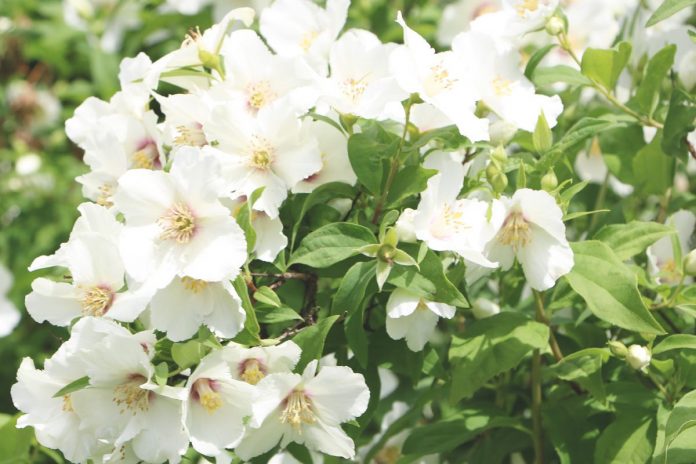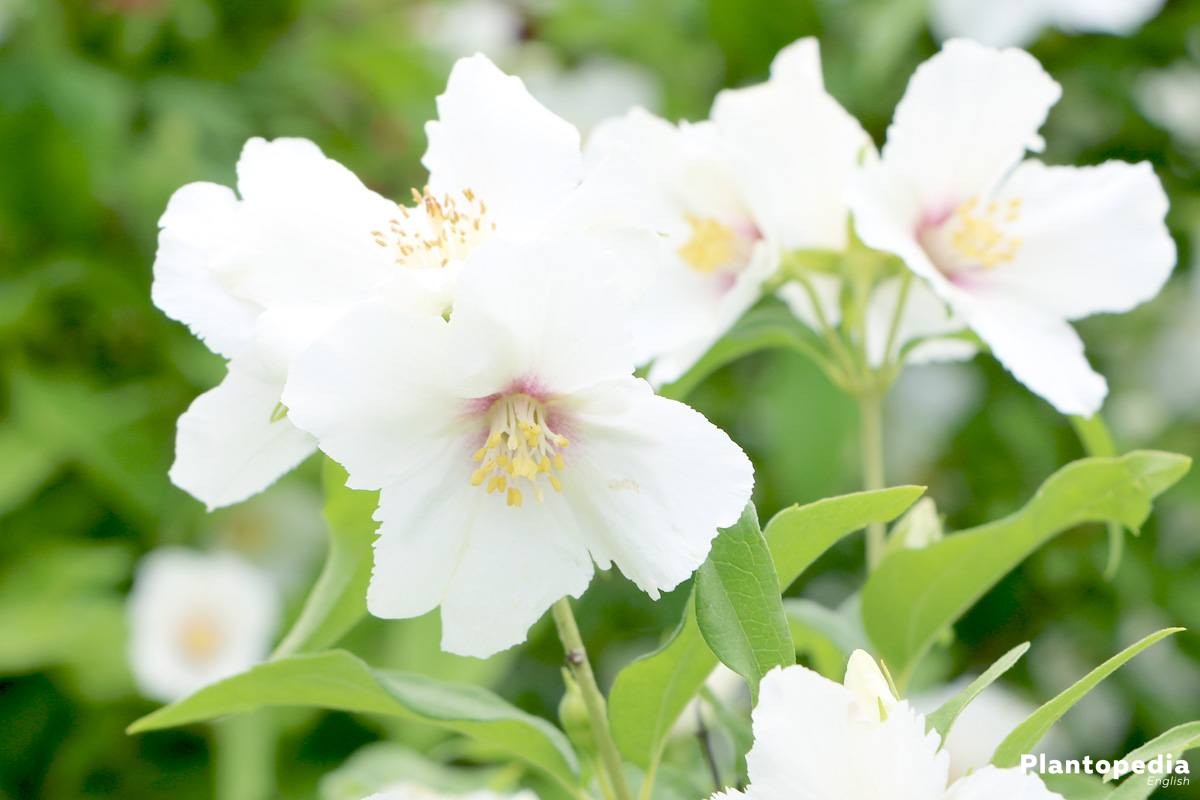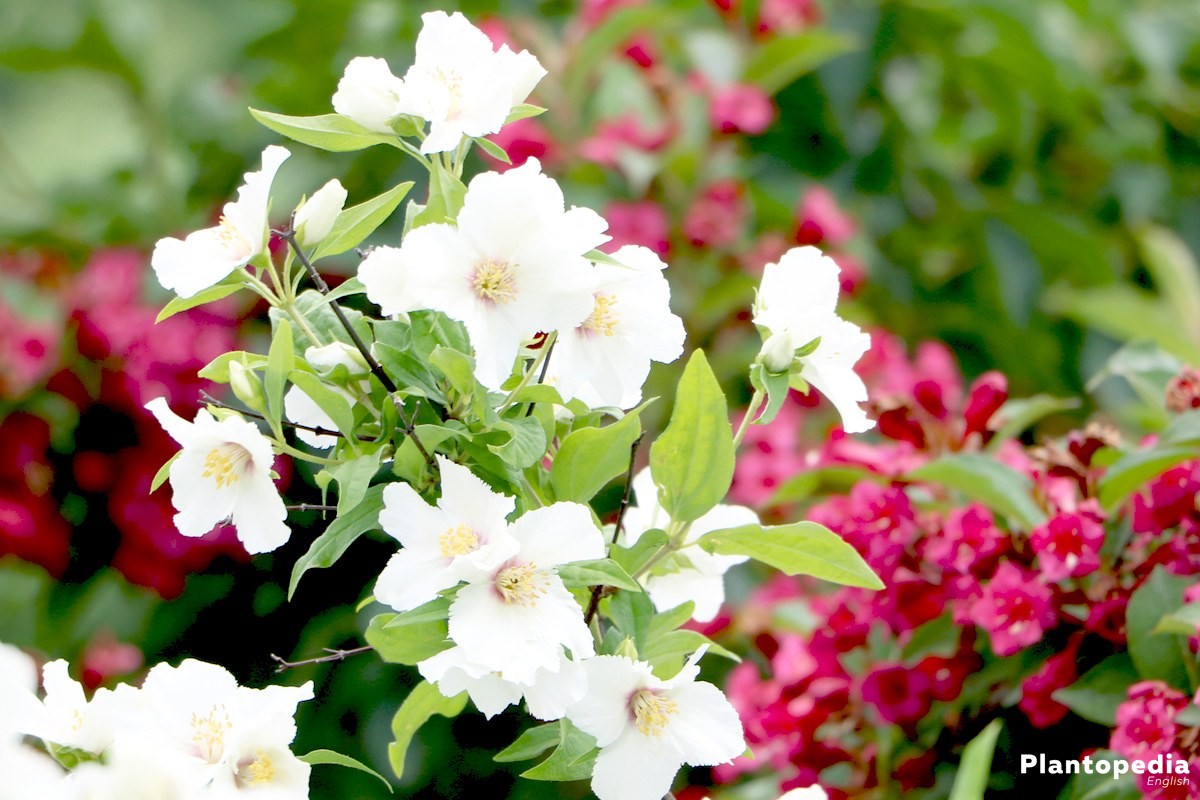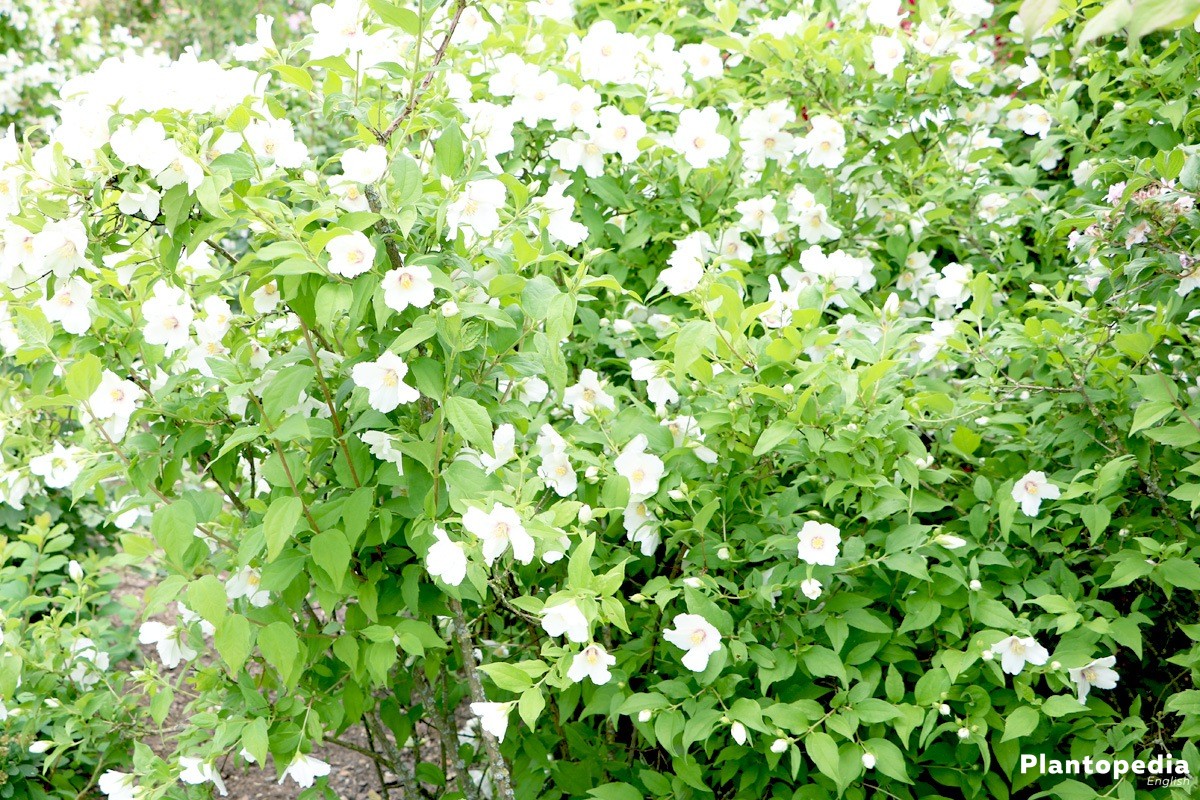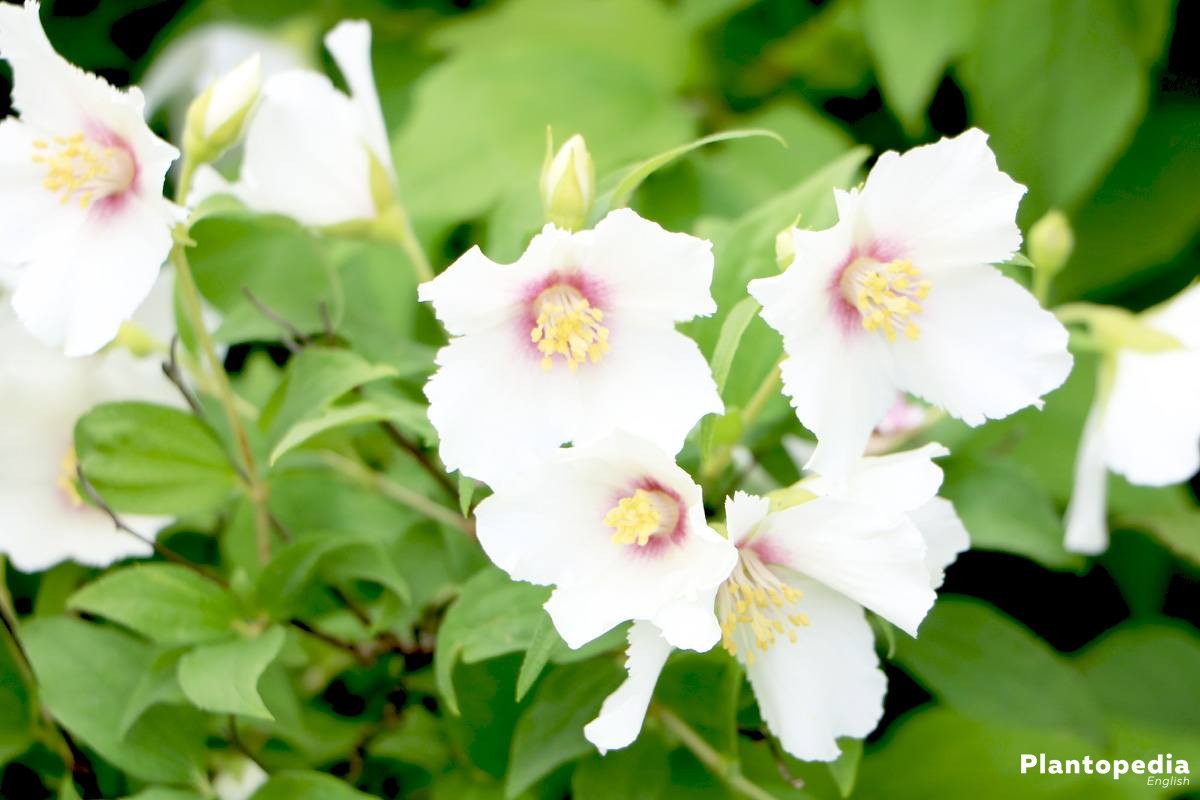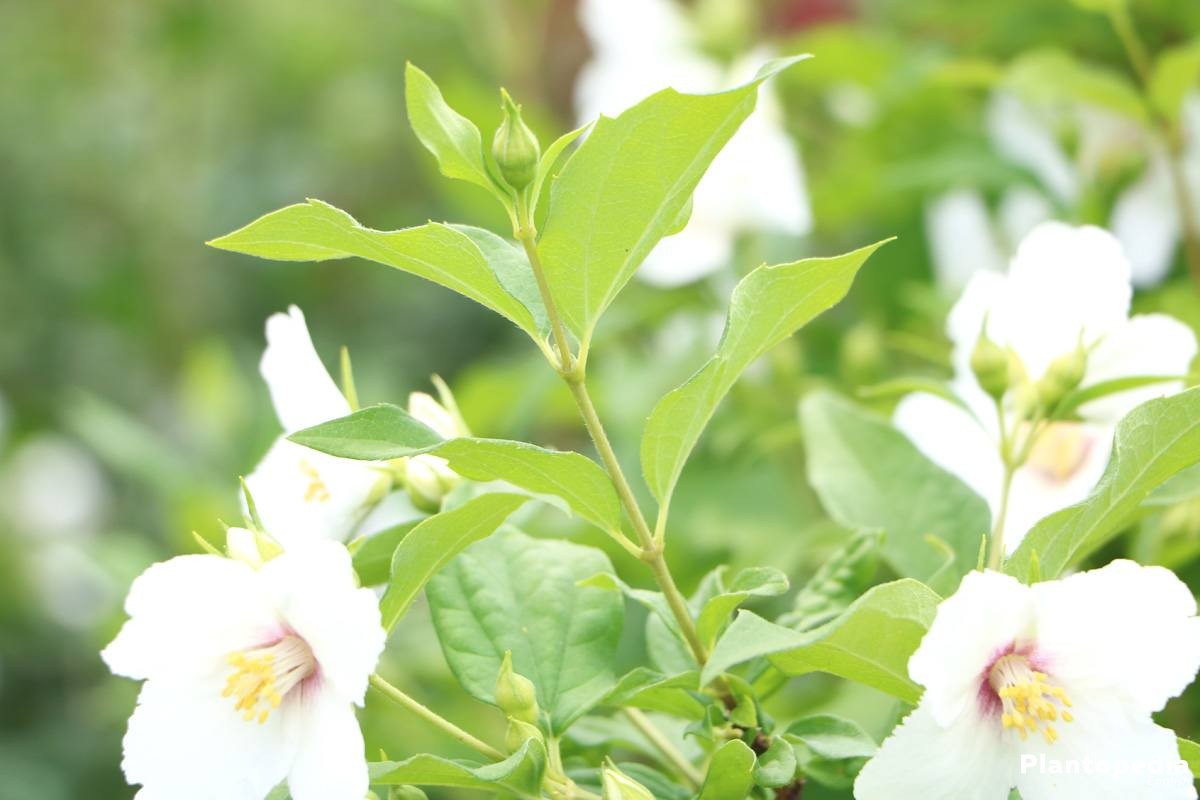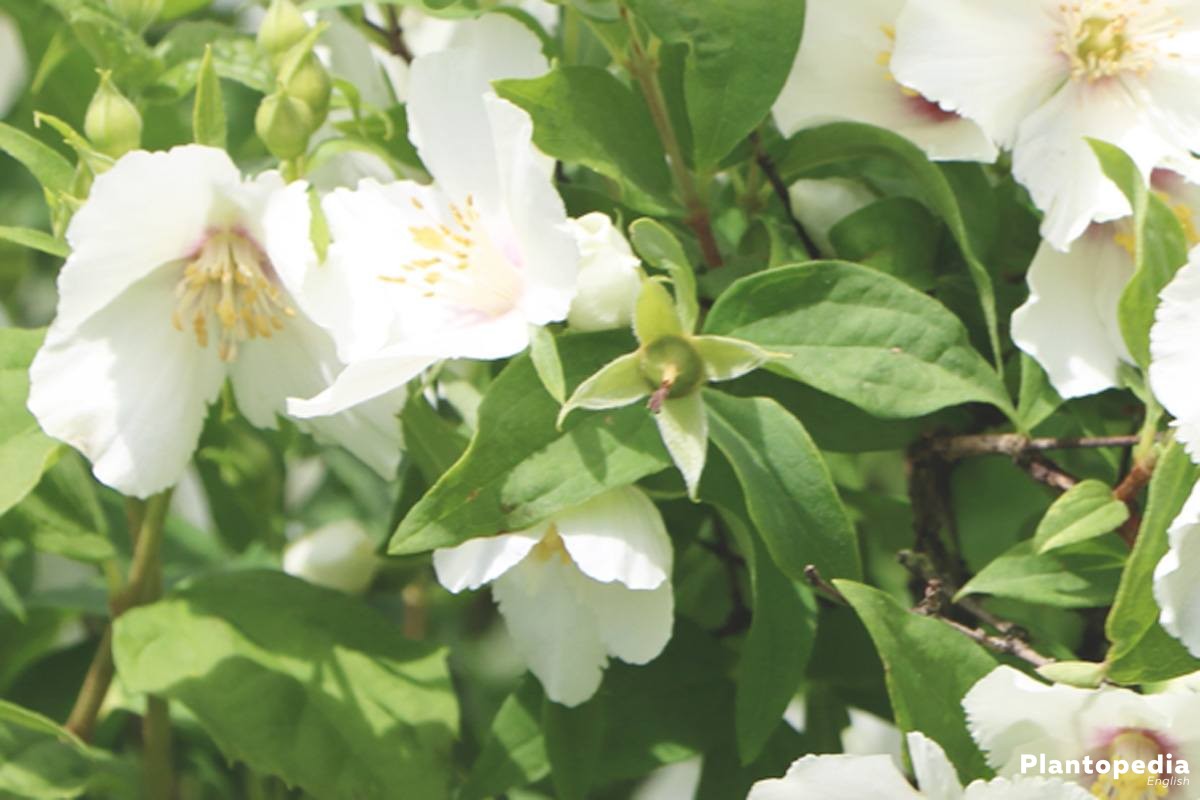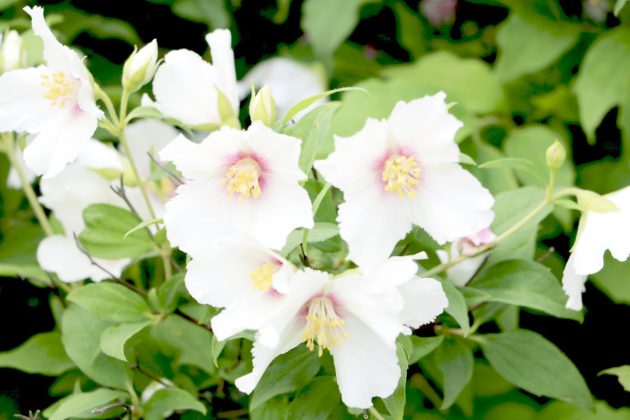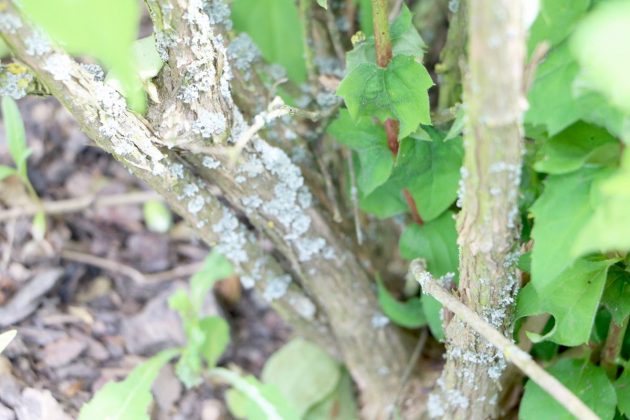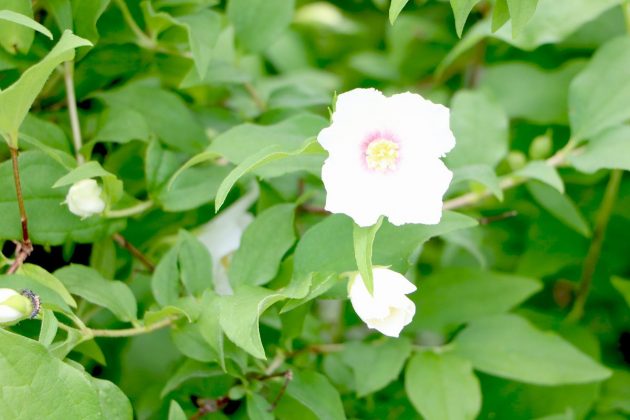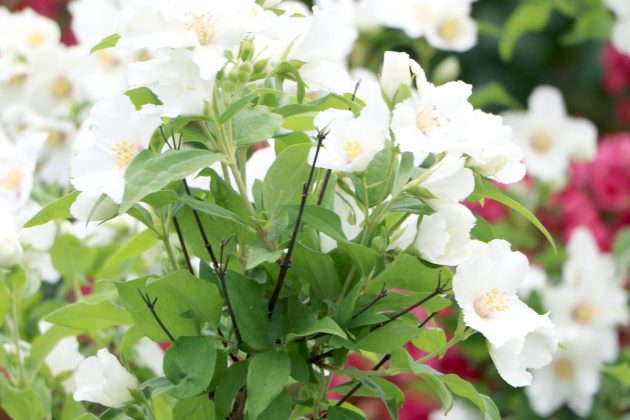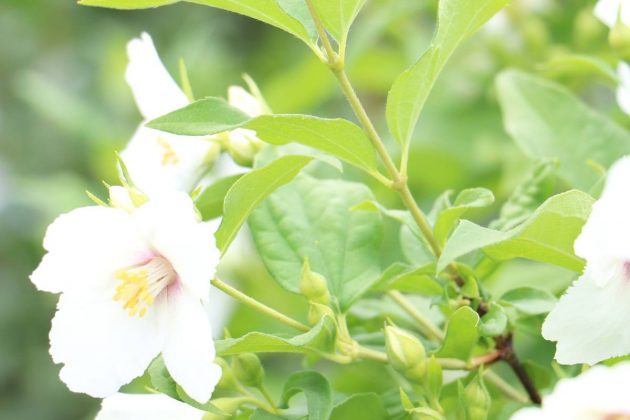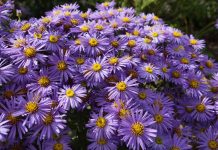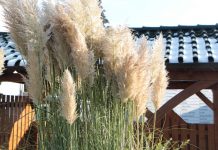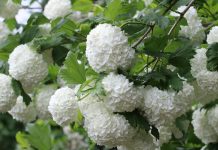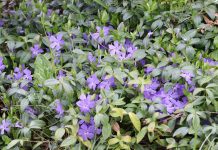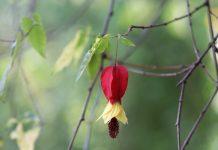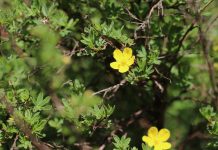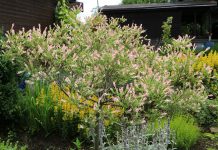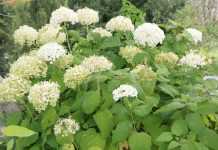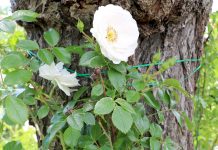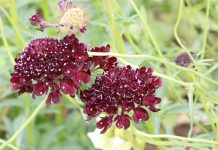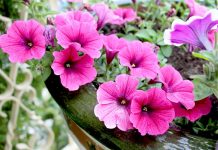The Philadelphus, also known as sweet mock orange, scented or farmer’s jasmine is a grand and low maintenance ornamental shrub. One can not anymore think of his country or farmers garden without it anymore. His filled or unfilled blossoms which are purely white are especially marvelous and emit an intensive odor. It unfolds his full might being single just as much as in combination with other shrubs or a hedge plant.
Plant Profile
Contents
- Family: Hydrangea plants
- Species: Philadelphus
- botanical name: Philadelphus
- german name: Philadelphus, sweet mock orange, scented jasmine, farmers or summers jasmine
- Origin: South East Europe
- growth: shrub, straight upward, slightly overhanging above
- growth height: 150 – 400 cm
- growth width: 80 – 120 cm
- blossom: pure white blossom bushes, simple or filled, often emits strong odor
- flowering period: depending on the variety from May until July
- leaves: different hues of green, rarely white green and yellow variegated
The Philadelphus shrub contains around 60 varieties and belongs to the summer green shrubs which are throwing off foliage. The plant has its origins in south east Europe and Italy and grows straight upwards and is slightly overhanging in the upper part. Depending on the variety, it can reach heights of up to 150 to 500 cm.
Characteristic for this shrub are the rough leaves which appear in several hues of green and are growing in a tapered fashion. The leaves can also be white green or yellow variegated. The blossoms, which are arranged in blossom bushes, appear from May until June/July in a bright white color which emit an intensive odor in the evening hours.
Care
The Philadelphus shrub perfectly inserts itself into different styles of nature gardens, front gardens, farmers, wood or renaissance garden. While higher varieties are impressing in a solitary position or natural hedges, smaller examples decorate front gardens and mixed displays. A planting in combination with spirea shrubs, Potentilla fruticosas, lilacs, beauty bushes and roses or flowering perennials like the blue larkspur or the Philadelphus are a real eye catcher. All varieties are robust, exited to blossom and low maintenance in care.
Location
This happy to blossom ornamental shrub flourishes incessantly at sunny to half shady locations. Blossom growth is severely mitigated at full shady locations. Due to the high amount of space the growth of this ornamental shrub needs, one should plan for enough space when choosing a location. Otherwise it has to be cut more frequently.
Soil
The Philadelphus is handling itself well in every kind of garden soil, however prefers fresh to moderately moist, nutrient and humus rich and above all permeable soils. Soils which are too meager can be optimized by adding compost, horse dung and bark humus while soils which are tending to compress can be loosened which fine grit, quartz sand and lava granulate. Fully unsuitable are location which are dry and run dangers of water logging.
Planting
The best time to plant the sweet mock orange is in autumn. The root bale should by meticulously water before planting, the soil should be loosened around the planting area and moreover freed of any weeds. The plant hole should be twice as big as the root bale, so that the root system can grow without obstacles. By adding into the hole horn shaving, bark humus and horse dung, perfect starting conditions are being created for the Philadelphus shrub.
- recommend in the case of a hedge planting are distances between 50 and 70 cm
- the plant is being filled up and is to be placed in the center of the plant hole
- the initial plant depth should be maintained
- subsequently, the hole should be filled with earth, the earth tightened and sufficiently watered
- a layer of mulch, foliage or grass are protecting against drying out
- prevent planting adjacent to ordinary snowball or spindle shrub
- the black bean live survives in these shrubs
This shrub doesn’t like being in buckets, even with an ideal supply. This is because of its uninviting heart root system. It affects the high varieties as well the small varieties and the compact hybrids. Growth and blossom growth are significantly less intensive compared to the planted out specimens.
Watering
While the water needs of freshly placed plants is relatively high, it sinks with increasing age. One should water more often during the first months and years. The soil should at no time dry out and not be too wet. With several years of age, watering should only occasionally be done. When the plant is located at the same location for several years, it usually supplies itself if there are enough amounts of rain water at its disposal.
Fertilizing
In order to fulfill the relatively high nutrient needs, a standard fertilizing at the time of planting in the form of compost, horn shavings, bark humus or horse dung is ideal; later in spring, compost should be added. It is important not to use a fertilizer too rich in nitrogen. Too much nitrogen would lead to a strengthened leaf growth, under which the blossom growth suffers. The blossom growth could possibly fully fail.
Cutting
Even though the Philadelphus shrub doesn’t have to necessarily be cut, under some circumstances certain cutting measures can make sense. The first cut should however not occur before the third or fourth year. Recommended are light form cuts immediately after the flowering as well as cutting measures to rejuvenate, preferably in autumn or winter, when the plant has lost its leaves. Vital are regular cutting measures on hedges. These are harming the growth of blossoms though.
Form cut
Regarding a form cut, this shrub is not being treated like an ordinary summer bloomer because it blooms, like otherwise spring bloomers, on last year’s wood. A cut in spring would lead to the circumstance, that the buds which have already developed with be included in the cut. Accordingly, in the event of a form cut after the flowering, only shoots which are too long are being cut.
Rejuvenation cut
- in order to rejuvenate the plant, only older branches are being removed at times
- this encourages the growth of new shoots and protects the plant of growing bare
- thin out about every two to three years in late winter
- remove over aged wood close to the bottom
- regularly cut out dried out, weak and shoots which are too close together
- sometimes, even deeper cuts up into the old wood are being tolerated
- still, cuts should not be made deeper than 30 cm over the ground
- a cut made too deep cut lead to the plant dying
Solitary plants should be allowed to grow unhindered so that its natural growth potential is being maintained. Only when they have grown too big or uninviting should they be cut lightly.
Hibernation
Sweet mock orange is, compared to the real jasmine fully winter hardy. This is especially true for older plants. They are thriving fully without winter protection and tolerate temperatures of up to minus 30 degrees. Young plants first have to develop a certain frost tolerance. Recommended for them is a light winter protection in the plant year in the form of a cover with foliage, pine brushwood or grass cut. The upper surface plant parts can covered with garden fleece or jute in order to protect the buds which have already grown.
Multiplication
The multiplication is relatively unproblematic and especially useful, when there is more than one plant needed, e.g. for planting a hedge. This can occur by seeding as well as through cuttings or hardwood cutting. Cuttings are leaved sprout parts, which are being cut after the blossom. On the other hand, hardwood cuttings are wooden, without leaves and are being cut between autumn and spring during winter storage.
Seeding
A multiplication of the Philadelphus shrub by seeding is generally possible but significantly more complex and long winded than a multiplication with cuttings or hardwood cuttings. Also, one should know the most Philadelphus shrubs are so called hybrids which are usually not creating any seeds.
If one has a pure variety, the seeds needed for a seeding can be harvested in autumn and be dried during winter. The following spring, they should be seeded out in little propagators in cultivation soil. If the seedlings big and strong enough, they can be placed in the garden as soon as there are no expected night frosts.
Cuttings
- cut 20 cm long shoot tips after the blossom
- the lower leaves are being removed
- the upper 4 – 5 leaves on the cutting are being halved
- this is how evaporation is being held as little as possible
- place cuttings in little pots with a sand peat mixture
- or plant them directly into a sheltered spot in the earth
- until rooting, the substrate must be kept consistently moist
- for ideal conditions, cover the cuttings with light permeable foil or plastic tarps
- remove both once in a while for a short amount of time in order to prevent the occurrence of fungal diseases and rotting
- cuttings are sensitive to frost, which is why a cultivation in a bucket is recommended
- this is how they survive indoors during the winter
- plant them at their eventual location after the ice holies
- it can take two to four years until the first flowering
Hardwood cuttings
In winter, for instance during the winter cut or thinning out, wooden shoots with a length of 15 to 30 cm are being cut. These should be pencil strong and be cut from last year’s shoots. One always cuts approximately 3 mm above or below an eye, whereby the hardwood cutting should always contain a minimum of two, or better four to five buds. The subterranean buds will grow roots and shoots out of the upper surface shoots.
It makes sense to cut the upper one straight and the lower one with a slanting movement and to place the hardwood cutting with the right end into the earth. Ideally, hardwood cuttings are being planted directly after the cut. Hardwood cuttings have to be put into earth deeper than cuttings. On a sheltered, half shady spot in the garden they are being planted with a depth, that at the most a quarter of the hardwood cutting peeks out of the earth.
Possible is also a cultivation in pots or buckets. The substrate should, during the cultivation period, be kept constantly moist. With an increasing warmth of the soil in spring, the hardwood cuttings will increasingly fast grow roots and shoots. If one cuts the young shoots as soon as they have reached a length of 20 cm, a bushy growth is being encouraged.
Parasites
Facing diseases, the Philadelphus is quite strong. The intensive odor of the blossoms lures a multitude of useful insects but also parasites like the black bean lice. The black live are primarily sitting on young shoots, lower leaf sides and blossom buds. Even rolled in leaves and crooked shoot tips are indicating a leaf lice infestation. If this happens, one should always immediately act in order to prevent a spreading.
With a strong water stream, a light infestation can be prevented or at least significantly diminished. Useful are compounds which contain rape oil or are based on potash soap. Useful as well is the usage of the green lacewing larvae, ladybug, hover fly or the gall midge. A close position to ordinary snowball or spindle tree should be prevented at all cost. The black bean live hibernates on these plants and settles on the Philadelphus shrub in summer.
Varieties
Philadelphus coronarius “Aureus” – Gold farmers’ jasmine
Philadelphus coronarius “Aureus” belongs with growth heights of 150 to 200 cm to the smaller varieties. Its yellow foliage can be seen from afar. The white blossoms are unfilled with a strong sweet scent. The flowering period lies between May until June.
Philadelphus Hybride “Erectus”
The species impresses with a lean growth with overhanging shoots, middle green foliage and growth heights of up to 150 cm. The ordinary hibiscus white blossoms with purple basalt spot in the center are showing themselves in June and emit a pleasant smell. It blossoms from June until July.
Philadelphus “Snowstorm”
The small, bright white, scented blossoms of this variety are densely filled and form a nice contrast to the green to dark green foliage. It reaches growing heights of up to 200m and flowers from June until July.
Philadelphus “Virginal”
The middle sized blossoms of this extraordinary variety which likes to blossom are filled and are spreading a sweet odor. In late summer, a night blossom is possible. It grows between 250 to 300cm into the air and up to 200 cm wide. Flowering period stretches from June to July.
Philadelphus coronarius “Variegatus”
Philadelphus coronarius “Variegatus” belongs to the rare varieties with white colored or creme white edged foliage. The creme white scented blossoms are appearing from May/June to July. They reach heights of up to 250 cm.
Philadelphus inodorus var. grandiflorus – great blossomoed Philadelphus shrub
This Philadelphus shrub reaches heights of up to 500 cm. With approximately 5cm, its simple white blossoms are relatively big. Flowering period lies between June until July.

